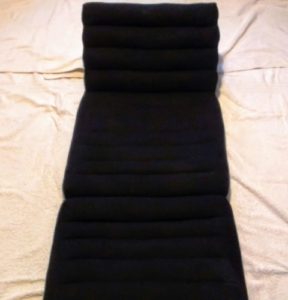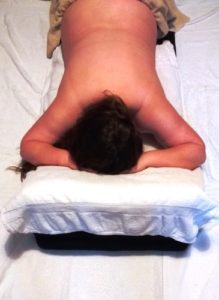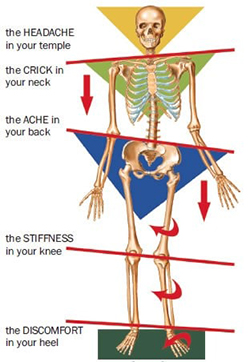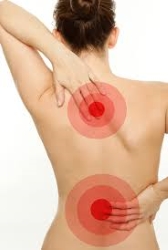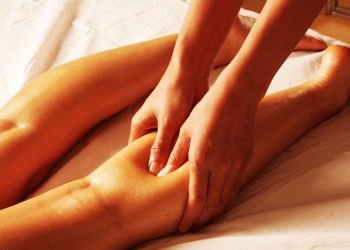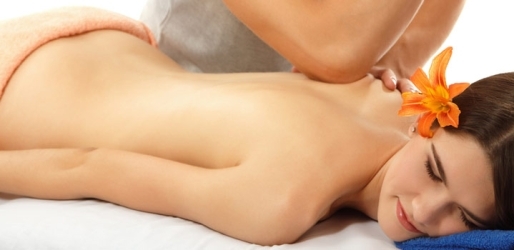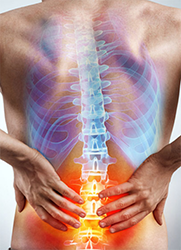
As a massage therapist in York, I most often give sports massages for lower back pain. Back pain can start as a small ache or twinge that you feel now and again. Something which comes and goes that you treat with a hot bath or painkiller. But then it hurts more often than it doesn’t and before you know it the pain is constant and seriously affecting your daily life. Even if it seems like it came on more suddenly, your muscles were no doubt tight long before that. There are many possible causes, such as prolonged sitting or standing, poor posture, jogging or weight training. But these are just the most common and it’s important to figure out the source of yours to help prevent it returning in the future.
Let’s start with a few examples before moving on to how a sports massage for lower back pain can help.
Lower Back Pain When Sitting
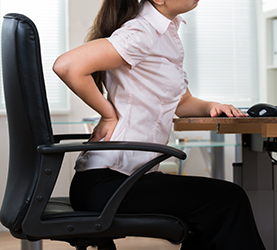
Some health experts have said that too much sitting is as bad for our health as smoking(1). Whether or not this is true, it’s definitely bad for your back. If your lower back pain is like an ache when you’re sitting, there’s a good chance that prolonged sitting is what caused it in the first place. This could be from driving in York, working at a desk, or slumped on the sofa working from home. Unless you have a very strong core that can keep your back in its correct position for several hours a day your muscles are going to be tight. And tight muscles eventually become sore and inflamed, even when you’re not sitting.
But Is It Just Your Lower Back?
If prolonged sitting is the reason you’re wanting of a sports massage for lower back pain, it will definitely help. But the area most in need might not be in your lower back, it could be the muscles of your hips and glutes. When you’re in a seated position, your hip muscles contract and become shortened. As are your gluteus medius, gluteus minimus and piriformis. This means they will tighten up, become inflamed and have reduced blood supply. And that can send pain into your lower back. The job of those muscles is to assist with hip abduction when you’re walking. When they’re tight however, your quadratus lumborum (QL) has to take over. This back muscle now has to do a job it wasn’t designed for, which further stresses something that is already a tight and weak.
Lower Back Pain When Standing
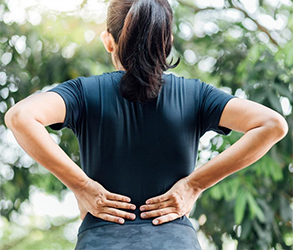
If your lower back issues are at their worst when you are standing, or straightening up after bending forward, the cause is likely to be related to your hips and glutes. As mentioned earlier, sitting for long periods can tighten up those muscles and affect your back. But so can prolonged standing. This doesn’t mean when you’re walking around or being generally active though. It means standing in pretty much the same place.
Jobs such as a barrista, factory worker or chef are good examples(2).
Why Is This Bad For Your Muscles?
This position shortens your glutes and your lower back, leading to a lack of flexibility in these muscles. Specifically, your gluteus maximus and medius and your quadratus lumborum (QL). As well as your erector spinae muscles which run alongside your spine from your lower back up to your neck. And let’s not forget your hamstrings, already tight from sitting and driving, which can tighten further, adding to the discomfort.
Bending forward becomes a particular struggle when these shortened muscles tighten further, leaving your lower back feeling stiff and achy.When you do, all of these muscles have to stretch, which they no longer find easy. And because your glutes can’t do the job they’re meant for, your hamstrings and especially your lower back have to try to take over. This can turn a chronic back ache into a jolt of sudden of pain. Even if it’s something as simple as putting on your socks in the morning.
Lower Back Pain In Bed
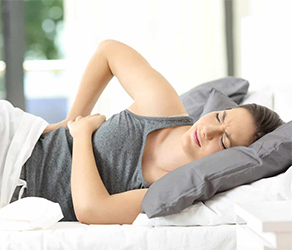
If you struggle through the day with back pain you can at least check your sitting and standing posture. You can also do some gentle stretches and mobilisation exercises to help prevent things getting worse while you have treatment. For some people, laying down takes all of the pressure off their back and allows them some relief. But for others, laying down, especially in bed, can make things even worse. And a good night’s sleep free from waking up every time you turn over a distant memory.
Getting Up Can Be Even Worse
You might also find sitting up to get out of bed in the morning just as difficult. And instead you have to wriggle on to one side so you can get your knees underneath you and then roll to the floor. This problem can be caused by issues which have been mentioned before. A tight quadratus lumborum (QL), erector spinae and tight glutes.
If you tend to sleep on your front or back this puts these muscles in a very short position. As a result they will stiffen up during the night. Sitting up to get out of bed then requires these muscles to stretch, which is what causes the pain. Side sleeping stretches one QL while shortening the other, creating a muscle imbalance that can contribute to pain. Especially if you have a soft mattress(3). Then when you try to turn over you are asking these muscles to work and for the shortened muscle to stretch. Not only can this action be very painful it can also cause injury in the form of a muscle strain.
Exercise And Lower Back Pain
There are many causes of lower back pain while exercising, whether this is group classes, lifting weights or jogging. And while the muscles involved are usually the same, the reason why you are having problems with them can differ.
Lower Back Pain From Deadlifts
If deadlifts are your issue, such as a sharp pain or stiffness during the exercise, there are two main reasons. The first is glute muscles that are too tight or weak to allow you to bend at the hip. The second is a tight QL and erector spinae muscles trying to do a job they’re not designed for. Both of these things will also prevent you from maintaining a correct S-shaped spine and instead it will be more C-shaped. If you are doing squats, these tight muscles will instead cause an excessive lumbar curve. And this will put a lot of pressure on your lower back.
Lower Back Pain When Jogging
If jogging around York is when you feel your lower back pain, a common reason is tight glute muscles. Specifically, your gluteus medius. The reason for this is when you run (or walk) it should be doing the job of hip abduction. But if it’s tight and weak your QL has to do the work instead, which puts excessive strain on your lower back. Running on hard surfaces like pavement or roads can further exacerbate the situation.
Lower Back Pain From Exercise Classes
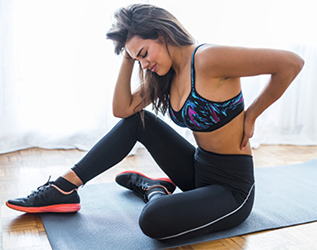
The two previous examples can cause your lower back pain even if you’re concentrating on your technique. But doing them at speed in a group exercise class such as Body Pump can be just as bad if not worse. Countless reps involving bending, lifting and twisting with no time to think about that twinge in your back can all add up to a major problem. And a tight muscle anywhere can lead to compensation by others that shouldn’t really be involved in that movement.
Poor Posture And Lower Back Pain

Having a good posture means your body is in its optimum position for what it’s doing. Whether this is sitting, standing, picking something up, running, doing a specific exercise at the gym, DIY, gardening, using your phone or laptop or even sleeping. If your posture is good, you are less likely to get injured. This is because you are using your body as it was meant to be used. If it’s bad you could be using the muscles on one side more than the other. Or making them work in a way they’re not designed to.
It could be that many years ago you had an accident or injury that caused a small change to your posture you were unaware of. And over time this has developed into something far more significant in that area. Or it could have progressed to the point where the painful muscle is not the one you originally injured(4).
What Does This Have To Do With Lower Back Pain?
Well, if you have a poor posture it affects the way you sit, stand, move and lift. Instead of maintaining a healthy S-shaped curve, chronic poor posture can gradually flatten your lower back, setting the stage for potential discomfort. Especially if you slump in your chair.
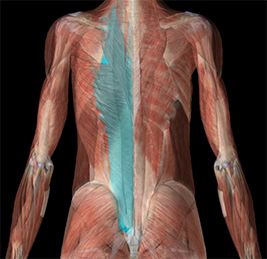
Another common cause is picking things up by bending at your waist rather than your hips, which can lead to a strain or even a slipped disc. In turn this can lead to excessive lumbar curve and be the cause of problems in your upper back. The reason for this is your glute muscles have become tight and therefore weak. This means that your hamstrings and lower back have had to take over the role to compensate. Your erector spinae and QL also then become tighter and therefore shorter, which is what causes you to have a poor posture. And your poor posture is what can cause lower back pain.
Muscles Targeted In A Sports Massage For Lower Back Pain
This article has highlighted the quadratus lumborum (QL), the erector spinae and the gluteus medius muscles as major contributors to lower back pain. But where exactly are they and how will a sports massage for lower back pain help?
The Quadratus Lumborum (QL) And Erector Spinae
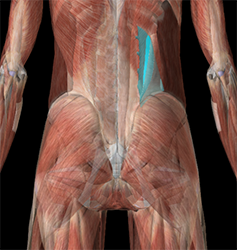
The QL is a deep muscle in your lower back. It runs from the iliac crest of your pelvis and connects to your lumbar vertebrae and lowest rib. If just one side contracts you will bend to that side at the waist. If you are already bending forward and both sides contract they will straighten you up to an upright position.
The erector spinae is a group of 3 muscles alongside your spine. They run from the iliac crest of your pelvis all the way up to your head. Like the QL, if one side contracts you will bend to that side, if both sides contract you will straighten. The difference is that the erector spinae affect the length of the back, therefore keeping it straight during a deadlift type movement.
Tightness in the erector spinae or QL will contribute to an excessive lumbar curve. And it is tightness, overuse or incorrect use of these muscles that is most often responsible for lower back pain.
The Gluteus Medius
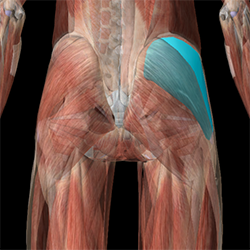
Although you are less likely to feel pain in your gluteus medius, issues here are often the initial cause of your lower back pain. It is hidden deep under your gluteus maximus (buttock) and connect your femur (thigh) to your pelvis. When contracted it abducts your hip, meaning it moves one leg away from the other. It also stabilises your pelvis when you walk or run. Problems arise when you do something that involves bending at the waist, especially with a heavy weight or when twisted. It is tightness or weakness here that contributes to incorrect use of the QL.
How A Sports Massage For Lower Back Pain Can Help

A sports massage at home for lower back pain would initially focus on reducing the discomfort in your QL and erector spinae. This means getting rid of any scar tissue that has built up and increasing blood supply to the area. As well as increasing flexibility to allow your pelvis to move more freely. This is likely just a symptom of issues with your gluteus muscles however. So in order to prevent your back issues returning the underlying cause should be dealt with by also massaging your gluteus medius.
How To Book A Sports Massage For Lower Back Pain
If you would like to book a sports massage for lower back pain in York please contact me on 07713 250352 or email david@massageinyork.co.uk. Includes sports massage, deep tissue massage and Swedish massage. For more information on booking click here

